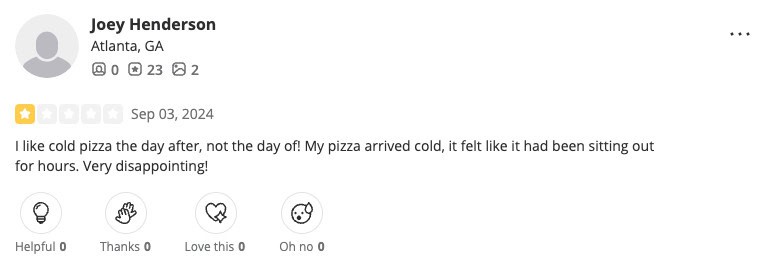The Importance of Customer Reviews for Pizza Restaurants
In today’s hyper-competitive pizza market, customer reviews can make or break your business.
While a glowing review may bring in new customers, a single bad review could drive them away—sometimes for good.
But what if those bad reviews weren’t just painful criticisms, but a roadmap to increased profitability?
According to our data, Limited Service restaurants with an Average Star Rating (ASR) of 4.4 or higher enjoy average weekly sales of around $57,000. Meanwhile, those with a 3-star rating or less pull in only $30,000.
And for Full Service restaurants? The gap is even wider. High-rated establishments see weekly sales soar to $100,000 compared to just $30,000 for their lower-rated competitors.
How we developed the fixes for Customer Reviews Issues
So now that we can all agree that customer reviews are vital, let’s discuss how we developed the potential solutions for your Pizza Restaurant brand.
Black Box Intelligence works directly with restaurant operators across the industry, providing data-driven insights and solutions that help brands improve operations.
We have a passion for the industry, as well as the guests and their experience.
As a trusted partner to some of the top restaurant chains, our team understands the challenges facing restaurants today and how to turn feedback into results using data.
By leveraging real-time data and industry expertise, we help our clients drive profitability and enhance customer satisfaction.
We know that every restaurant is different. But we also know that data doesn’t lie.
Using learning software, we take a look at the most common complaints and regularly walk-through solutions as a true partner to our restaurant clients.
So let’s break down the most frequent negative reviews we see and how to turn them into positive improvements.
Issue 1: Burnt or Overcooked
When pizzas are burnt, the taste, texture, and overall quality are significantly impacted.
Therefore, this leads to dissatisfied customers who are unlikely to return.
Even worse, it leads to bad reviews.

Negative reviews can harm a restaurant’s reputation.
Furthermore, they can mean potential customers writing you off before seeing your menu.
The financial impact includes potential revenue loss from diminished repeat business.
In addition, the cost of replacing overcooked pizzas can eat into profit margins.
So, what to do?
Next, take action. Address this complaint by improving your process.
This will be different based on your needs, but may look like:
- Setting Up Quality Control Checkpoints:
Implement a mandatory visual and texture inspection before a pizza leaves the kitchen.
- Establishing Cooking Time Guidelines:
Create a detailed guide for cooking times for each type of pizza (thin, thick, gluten-free, etc.) and provide training sessions for all kitchen staff.
- Building an Oven Calibration Schedule:
Set up a monthly oven calibration schedule to ensure temperature accuracy.
Issue 2: Undercooked Dough
Undercooked pizzas with soggy or doughy textures are about as tasty as they sound.
This complaint can leave a poor impression, making customers feel the restaurant is careless or inexperienced.

The financial impact includes increased food waste due to returned orders.
More importantly, it leads to lost revenue from unhappy customers who may not return or recommend the restaurant.
In fact, it may even lead to customers advocating against your establishment.
As always, respond to reviews respectively and promptly then focus on internal improvements.
This may look like:
- Implementing a Consistent Cooking Method:
Standardize how long each type of pizza should bake and at what temperature.
- Investing in Better Equipment:
Consider using infrared thermometers to measure internal dough temperature for consistency.
- Using Visual and Tactile Cues:
Train staff on specific visual cues and tactile cues to identify undercooked pizzas. This can be looking for golden-brown crust. Alternatively, it can be looking for a firm yet slightly springy texture.

Issue 3: Incorrect Orders
Multiple reviews for pizza establishments highlight receiving the wrong pizza toppings, missing ingredients, or incorrect customization despite specific requests.
Receiving a wrong order can frustrate customers.
Thus, this leads to complaints and a loss of trust.

This issue often results from miscommunication or lack of attention to detail.
Therefore, solutions can include:
- Double-Check Order Protocol:
Implement a two-step verification process—one person makes the pizza, and another verifies before baking.
- Use Tech Solutions:
Invest in a Kitchen Display System (KDS) that shows orders on-screen to minimize confusion.
- Pre-Shift Huddles:
Use pre-shift meetings to go over common mistakes and remind staff of the day’s specials or custom orders.
In addition, once you implement corrections, consider encouraging customers to leave more reviews.
This can help balance out negative reviews and even elevate your Average Star Rating.
Issue 4: Cold Pizza Upon Arrival
Numerous customers note that their pizza arrives cold, either when dining in or via delivery, leading to dissatisfaction.

That’s all to say, you should really pay attention to reviews with this complaint, if only for the sake of your bottomline and traffic growth.
Since this issue suggests that either the kitchen or delivery logistics need improvement, consider:
- Optimize Delivery Routes:
Partner with a route optimization tool to ensure that deliveries are as quick and direct as possible.
- Invest in Insulated Delivery Bags:
Upgrade to high-quality, heated bags for delivery drivers.
- Set Up a “Ready-to-Deliver” Staging Area:
Create a designated area with warming lamps where completed pizzas can be held at temperature until the driver arrives.
Issue 5: Greasy Pizza
There are mentions of pizzas being overly greasy, which detracted from the overall enjoyment.
Excessively greasy pizza can make the meal less appetizing and contribute to a negative perception of the restaurant’s food quality.

Financially, consistently greasy pizza may lead to decreased customer retention and increased ingredient costs if additional resources are used to improve the product’s quality.
This issue can be addressed by:
- Use Absorbent Paper:
Place pizzas on an absorbent paper liner right after cooking to soak up excess grease.
- Blot Before Serving:
Train staff to blot excessive grease before serving. Above all, do this with oily toppings like pepperoni or sausage.
- Check Ingredient Quality:
Source leaner meat toppings or switch to less greasy varieties of cheese.
Issue 6: Small Portion Sizes
There are issues regarding portion sizes, where the pizza was perceived as too small for the price.
This is especially the case when in comparison to previous visits.
When customers perceive portion sizes to be too small for the price, it creates a sense of unfair value.
This issue is often mentioned in reviews as a sign of declining quality or an attempt to cut costs.
Consider the following when making improvements:
- Re-Evaluate Pizza Sizes and Pricing:
Analyze if the portion complaints are consistent across a particular size (e.g., small pizzas) and adjust accordingly.
- Launch a Value Menu:
Introduce a value menu option where the focus is on affordability and customer satisfaction.
- Update Portion Descriptions:
Make sure menu descriptions match actual sizes to set realistic expectations.
Issue 7: Long Wait Times for Pizza
Some customers complained about having to wait too long for their pizza to be served.
Further, in cases where it was cold or overcooked by the time it arrived.
Long wait times can leave customers frustrated.
This is especially the case for pizza, since it is generally perceived as a “quick” food.
Therefore, this leads to negative reviews and lost business.
This issue may arise from inefficiencies in the kitchen or understaffing.
Solutions can include:
- Implement a Queue Management System:
Use technology to track and manage orders, allowing customers to see real-time updates.
- Revamp Kitchen Layout:
Optimize kitchen stations for efficiency, ensuring minimal overlap between staff during busy times.
- Pre-Make Popular Items:
For peak periods, have dough rolled out and pre-topped items ready to be baked, reducing cooking time for high-demand pizzas.
Conclusion
Customer reviews aren’t just feedback—they’re a powerful tool that can help your pizza restaurant improve and grow.
By addressing common issues like burnt pizzas, incorrect orders, or long wait times, you’re not only enhancing the dining experience but also boosting your bottom line.
Remember, every negative review is an opportunity to refine your processes.
Additionally, it can strengthen customer loyalty and set you apart from the competition.
By monitoring reviews and implementing these actionable solutions, you can transform your restaurant into a top-rated establishment that consistently delivers delicious, satisfying meals—every time.
So, keep an eye on your reviews, listen to your customers, and make the changes that matter to your customers’ experience.
Your future 5-star ratings (and increased sales) will thank you!
